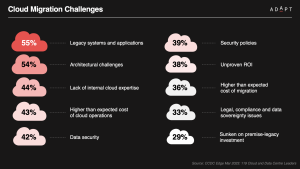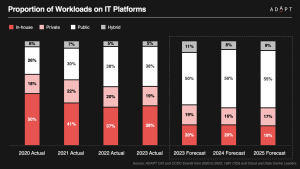55% of Australian Organisations’ Workloads in Public Cloud by 2025
By 2025, ADAPT forecasts that 55% of workloads for Australian organisations will be hosted on public clouds — bringing testament to the massive demand for public clouds for local companies. Several variables, including enhanced scalability, remote worker assistance, and manageable pricing, are responsible for this shift.
Shifting workloads to the cloud has become a top priority for many Australian organisations due to the pandemic’s exponential acceleration of digital transformation.
Since 2019, ADAPT has conducted an annual cloud migration study, based on the responses of nearly 2,000 Australian technology executives.
In this time, workloads have rapidly shifted away from in-house environments and into a diverse mix of public, private and hybrid cloud settings.
While many significant infrastructure projects were first put on hold by the pandemic, there is a sharp increase in demand for cloud migration support in Australia.
By 2025, ADAPT forecasts that 55% of workloads for Australian organisations will be hosted on public clouds — bringing testament to the massive demand for public clouds for local companies.
Several variables, including enhanced scalability, remote worker assistance, and manageable pricing, are responsible for this shift.
Server and storage sprawl led to server and storage consolidation followed by the need to consolidate data centres as operational costs and inefficiencies blew out. Cloud has, in many ways been seen as the saviour as organisations leaned into the concept of only paying for what you use, when you need it.
ADAPT’s Research and Advisory clients can access the full report on the State of the Cloud Migration in Australia.

Some of ADAPT’s most powerful insights on use of the public cloud over the past 4 years:
- Highly modernised organisations have 67% of their workloads in public cloud.
- Organisations who report plans to repatriate from public cloud are predominantly small/medium organisations, whilst no large organisations have expressed they will.
- 11% of Australian infrastructure leaders surveyed said they would repatriate from public cloud in 2023.
- According to Australian Infrastructure Leaders, Microsoft Azure and Amazon Web Services are the preferred public cloud vendors, while preferences for Google Cloud Platform is still emerging.
- Mission-critical applications, data, and productivity tools will drive the adoption of public cloud in 2025.
- Cost, scale, and lack of suitability for static workloads are the biggest reasons some leaders are repatriating from public cloud.

What’s holding back Australia’s cloud migration?
Deeply ingrained legacy systems frequently dispersed throughout an organisation are the main obstacle to cloud migration. It is expensive to migrate to the cloud at first, and it can be challenging to justify this cost while the current legacy environments function, albeit frequently inefficiently.
In addition to legacy systems and applications, the major obstacles to cloud migration are architecture, a need for more internal talent, and higher than anticipated migration and operation expenses.
“47% of CIOs said that finding cloud configuration experts is hard.”
ADAPT observed the challenges in cloud migration change based on the cloud maturity of organisations and found there are three distinct phases they proceed through.

The Hybrid Future of Australia’s Infrastructure
A hybrid combination of internal, private, and public clouds is used by many organisations.
More than five public cloud environments will be used by about 23% of organisations in 2022, an increase of 4% from 2021.
72% of those surveyed have one to five public cloud environments.
These numbers are shifting quickly as a result of data and cloud sprawl.
CTOs are adamant about pursuing a varied yet integrated cloud strategy despite their struggles to connect and consolidate many cloud environments.
Using a hybrid cloud strategy enables businesses to create and run apps anywhere.
The goal should be to create an application once and deploy it across architectures without changing the code.
Application development shouldn’t require consideration of a particular platform. When a partial migration to the cloud is not required, the cloud infrastructure must have a pay-and-use option to migrate back to an on-premises system once a project is finished.
Examine the capacity of your cloud platforms to connect to the data centre, generate more utilisation, handle peak loads, and obtain the highest return on investment.
ADAPT’s Research and Advisory clients can access the full report on the State of the Cloud Migration in Australia.
ADAPT gathers Australia’s top Heads of Cloud, Infrastructure, Data Centre, Architecture and Engineering from Australia and NZ’s largest enterprise, government and service provider organisations at Connected Cloud & DC Edge.
























